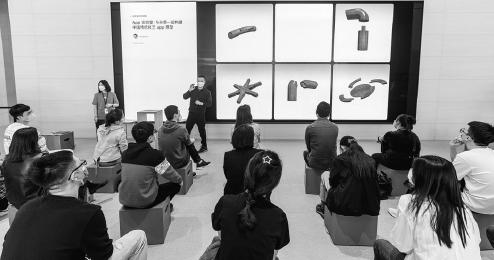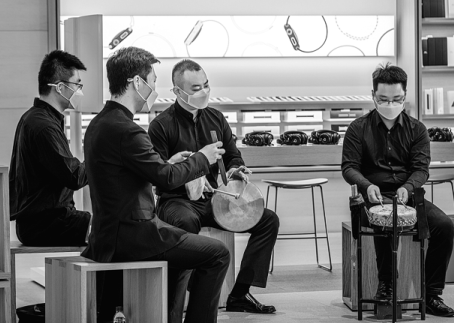Gaming culture
A slew of innovative mobile apps are helping young people tap into Chinese traditions in a thoroughly modern way, Fang Aiqing reports.

App developer Sun Yong believes the younger generations will still have the interest in traditional culture and history, but the key is to find the proper medium for them to enjoy it in an age where not many people have the time, or the patience, to read books.
Among his most successful productions is an app called Wood Joints that demonstrates 31 typical mortise-and-tenon techniques frequently applied in the manufacture of traditional wooden furniture.
China has a long history of woodworking without the use of nails, from making delicate wooden furniture to entire buildings.
The assembly of such complicated conjunctions results in a simple, smooth surface, which embodies ancient Chinese aesthetics and philosophies.
In the app, users are able to examine different structures using mortise-and-tenon joints and, with a series of clicks, take them apart to see how separate pieces of wood are bound together. They are also able to learn about the features of different kinds of wood, tools and techniques.
Sun's interest in carpentry dates back to his childhood. Born in the 1970s, there weren't many toys available when he was young, but the family used to make desks, chairs and wardrobes themselves. The woodwork appealed to him and, by watching and imitating the adults, Sun developed strong hands-on skills that he still feels confident about today.
From his perspective, traditional Chinese culture is something which, when he learns more about, he becomes more interested in, and feels an urgent desire to know more. He sees painting, music, calligraphy, architecture and lifestyle as all being connected and related to each other.
As co-founder of Tag Design, a startup design studio, in 2013 he came up with an idea for a project which would not be hampered by worries about cost and revenue.
Being interested in architecture, but finding it difficult to understand design drawings, Sun decided to create an app to showcase structural designs in a more visually intuitive way, and it started with common examples of mortise-and-tenon structures.
He shared his idea with his colleagues, explaining the workings of the wood joint, its classification and function, and how to read design drawings. Together, they also explored, with the help of professional carpenters, modeling the wooden structures by using three-dimensional techniques on mobile devices.
It took the team more than half a year to complete the app and, in June 2014, the iOS version for Apple devices was published. It was soon a recommended product in the Apple App Store and later won an award from the tech company.
The team got further encouragement when Apple CEO Tim Cook visited the studio in October 2015.From then to just before the outbreak of COVID-19, the studio released several more apps featuring other folk art crafts, such as folding fans, new year paintings and jade antiques.
Sun says mobile application technologies have enabled more people to learn about traditional cultural elements in a short time and in a convenient manner.
Stunning visual effects have also helped Ink, Mountains and Mystery, a phone game jointly developed by tech company NetEase and the Palace Museum in Beijing, garner a positive response from users, especially helping them appreciate the beauty of the traditional Chinese blue-and-green landscape genre of painting.
Blue-and-green landscape painting is a kind of ink-wash painting style in which the artist applies strong, vibrant palettes. This kind of painting style flourished during the Sui (581-618) and Tang (618-907) dynasties. However, the most renowned example of the style is A Thousand Miles of Rivers and Mountains by Song Dynasty (960-1279) painter Wang Ximeng.
Chen Mingyong, a game developer at NetEase, says the team planned to create an "authentic ancient Chinese-style game" that was different from the homogenous mobile games on the market at the end of 2016. Based on the results of a market survey, the team decided to borrow elements from ancient painting style.
They decided that the not-for-profit game would be driven by its visual appeal. At that time, the team had not even settled on clear rules for the game.
Born into a farming family, Chen didn't have the chance to learn traditional painting when he was young, but his career surprisingly brought him into this profound field.
The team extracted some traditional Chinese cultural elements such as bridges, streams and bamboo groves, while inserting red walls, peach blossoms and wooden pavilions-photos of which are very popular among young internet users.
They also paid a great deal of attention to telling the stories behind an ancient convention. For example, there used to be big nails on city gates, the variety and number of which was an indicator of social status.
In celebration of Spring Festival, people in ancient times would touch the nails and wish for peace and safety, while young women would do so hoping for pregnancy. As a result, the lower nails would develop a patina.
The team incorporated these kinds of cultural traditions, along with an explanation, into the game's tasks.
"Art is one manifestation of culture. What's more interesting for us is the invisible cultural meanings that can cross the gap of time," Chen says.
According to Chen, the market for ancient Chinese-style games showed very little potential in previous years and few programmers knew how to incorporate ancient culture into games.
Chen explains that it's probably because major game developers have to take the international market into account as the domestic game market has become more crowded and competitive.
To better design the game, Chen and his colleagues regularly learned and shared knowledge about detailed aspects of traditional culture, like traditional clothing and snacks.
Chen was also keen to note that the team also ensured delicate and ornately carved corbels appear on the wooden pillars of ancient buildings in the game that are located in the lower reaches of the Yangtze River.
These carvings used to be found in old buildings and were seen as a form of decoration, though in some cases they carried auspicious meanings.
However, the beauty of these carvings has faded away as modern skyscrapers gradually occupy the cities, but they can be preserved in games instead.
During the process, the team, which is composed mainly of young, inexperienced programmers and developers, has gained an interest, and some level of expertise, in traditional Chinese culture as a result.
Chen describes the group as "traditional culture inheritors with market thinking", a quality he thinks is essential for creating innovation and bringing culture to a wider audience.
Chen says they are exploring ways to better convey the temperament of Chinese painting, instead of simply making the images look more vivid.
Sun and Chen are both lecturers for the ongoing "Today at Apple "sessions, being held at Apple's retail outlet in Sanlitun in Beijing through June 6. The sessions consist of 12 lectures about the melding of Beijing's local culture and the new technologies applied in the company's products.
"Today at Apple" programs are free, hands-on sessions hosted by Apple retail outlets since 2017 to help educate users about how to tap the potential of its products.
"The idea is about how we reach back into the creative cultural history in Beijing, because there's so much of it across all the different artistic disciplines and we want to connect it to our technology," says Richard Hames, senior market director for Apple retail in Asia-Pacific, adding that as the company moves further forward technologically, people are able to reach further backward in terms of traditional crafts.



Today's Top News
- Wang to meet foreign ministers of Cambodia, Thailand in Yunnan
- China's top legislature concludes standing committee session
- Thailand and Cambodia agree to temporary ceasefire
- NPC's 4th annual session slated for early March
- Civilizational links for a fairer world
- Manufacturing in China spurs global growth






























